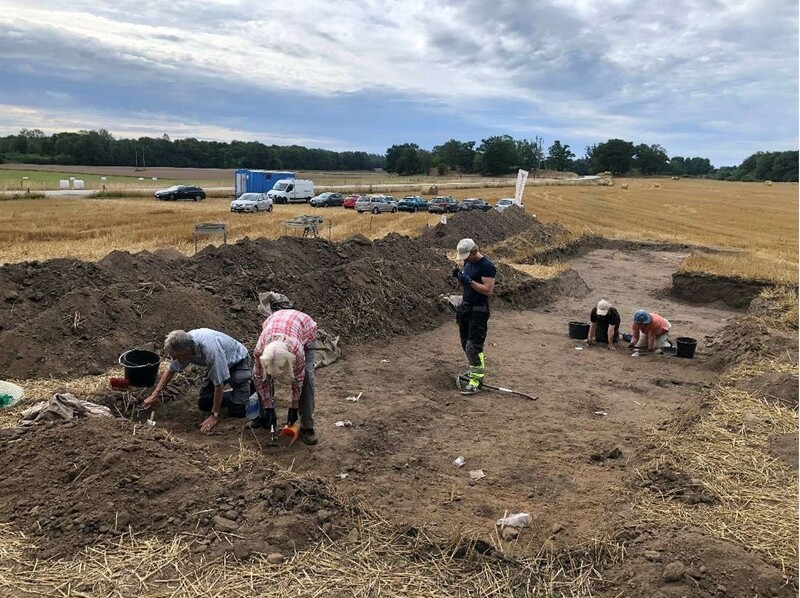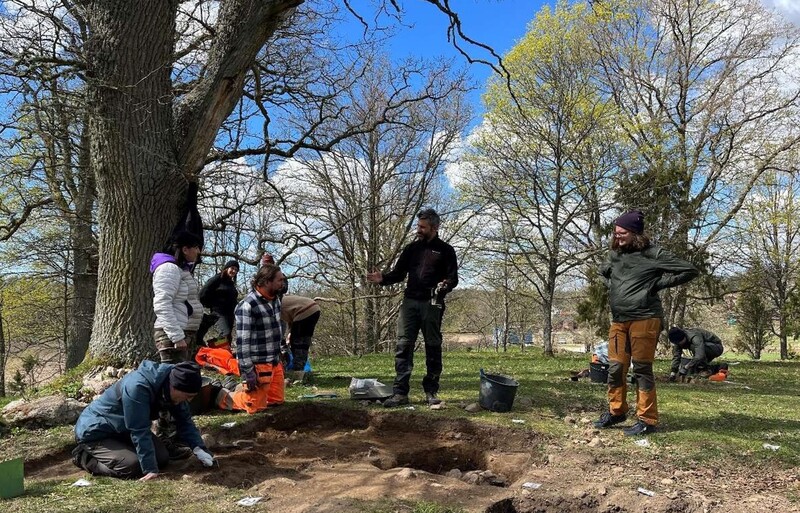Identifier
Title
Description
For logistical reasons, the investigations had to be divided into two field seasons. The investigation of the settlement (L1978:8879/RAÄ Hjortsberga 307) was extended to the period 18-29 August 2022. During this phase, a trench of just under 212 m2 was opened, with some overlap with the western part of the 2021 investigation area. Stripping was done in layers with an excavator, during which surface cleaning was done by hand. Finds encountered at the level of features and cultural layers were mainly surveyed with GPS or recorded manually on an analogue, scaled drawing, and finally screen-digitised against the digital property map in Sweref 99 (TM). Documentation was mainly carried out with a digital camera, but to some extent also through scaled hand drawing.
The second phase of the investigation was carried out on the hill (L1978:8860/RAÄ Hjortsberga 306) during the period 2-8 May 2023. Two trenches were opened (Trench A and Trench B (see appendix 3a and 3b). These partly overlapped with the trenches opened 2017-2021 (Trench A) and 2017 (Trench B). The previous trenches also had the same IDs in previous investigations (Henriksson 2018; 2020; 2021). Trench A measured 3 x 2 m in a north-south direction and Trench B just over 2 x 1.5 m in an irregular rectangular shape (see appendix 3b). In both trenches, the topsoil layer was removed by hand down to the cultural layer level where stratigraphic investigation took place. Documentation was carried out in its entirety by photogrammetric method (IBM) within the tool AIR (Archaeolo gical Interactive Reports), developed at Lund University (Derudas et al 2023).
In order to expand the interpretative basis for the complex stratigraphic situation on Vångkullen, all contexts that were interpreted to be related to the building or its preceding phases were sampled. In the northern part of Trench A, a smaller part was opened, which overlapped with the investigation trench from 2021. In this area, no features or layers were investigated, but the effort was focused on securing samples from the floor-layer sequence documented in 2021 (Henriksson 2022). Sampled material from the investigations in 2023 is intended to form the basis for future archaeobotanical and micromorphological analysis (see Appendix 3b).
As in several previous field seasons, metal detector excavation was carried out in 2022 and 2023 by free searching in predefined and previously evaluated sub-areas. This time, areas were also added around the Kasa Kulle grave field (Fig. 2).
Finds were collected in the larger trench to a large extent by hand picking in connection with topsoil stripping and in particular fine cleaning of the surface. In addition, finds were recovered during dry sieving of the stripped topsoil. The finds on the hill were recovered exclusively by hand picking in situ in connection with the ongoing 3D documentation. The finds from the detector surveys were continuously recorded on analogue field maps. These were rectified after the fieldwork, and then formed the basis for the creation of a GIS layer for the recovered finds, which formed the basis for a revision of the heritage site geometries in Fornsök.
Archaeological staff from Blekinge Museum and Lund University participated in the field. Metal detector surveys were carried out by three specially selected hobby detectorists with previous experience of work in Västra Vång. Volunteers from the archaeological societies of Kronoberg and Blekinge participated in the survey of the shaft in the field. Digital surveying was carried out by Andreas Svensson, Lund University and Niclas Olsson, Blekinge Surveyor. The conservation work was carried out by Max Jahrehorn, Oxider AB. The handling of finds done by Hanna Sjöberg and Siiri Irskog at Blekinge Museum and Sara Ahlgren, intern at the same institution.
Date Created
Rights Holder
License
Media (Images)
Linked resources
| VV2023 report 5 Trench A & B |


















| Plane | Position | Flip |
| Show planes | Show edges |
0.0
[ 0 , 0 , 0 ]







